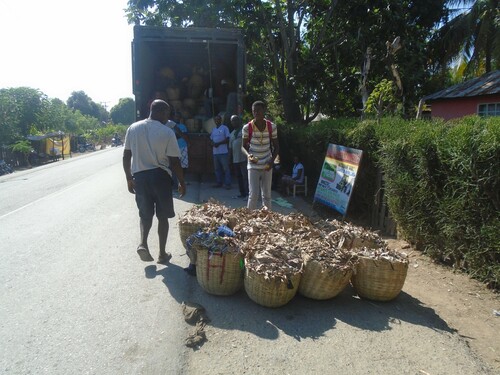If we consider the value of a panye (basket) in terms of a poor market woman selling mangoes in the local market, where 95% or more of all Haiti’s mangos get sold, there is clearly a price floor at which point it makes no sense to harvest and sell mangos. There is a point where the cost of simply getting them off the tree and moving them to market exceeds the benefits.
sold, there is clearly a price floor at which point it makes no sense to harvest and sell mangos. There is a point where the cost of simply getting them off the tree and moving them to market exceeds the benefits.
The Table on the right give gives the cost of each task in the harvest and post-harvest process as defined by Lidwine for the local market and Table 3.9 gives the cost to Haiti Hope PBGs. Translating this to a 5 dozen panye, the procurement costs of that panye in the Haiti Hope market chain is 77.5 HTG and in the local chain 37.5 HTG. If we then add the cost of the woman taking the panye to market and waiting around to sell it a minimum 100 HTG—the going rate throughout Haiti for a 6 hour work day– then the cost of procuring and selling the panye is 137.5 HTG. This does not include the cost of growing the mango.
What is the cost of having the tree? Lidwine et al (2012) put it at the cost of picking the mangoes (see Text Box 2.2). In other words, nothing. Alternatively, the cost of the tree could be calculated as the opportunity lost to planting other crops on the same land. While not provided here, the significant point is that cost is in fact limited.
Mango trees are not a “passive” or “cost free” resource as so commonly assumed by those who purchase or study them with the export sector in mind. The point is especially poignant when one considers that the average peasant household only has access to ~1 hectare of land (1,000 square meters), room for about 100 adult mango trees. Moreover, evidence seen elsewhere in this report indicates that they are in fact often getting sold and that they have a value equal to or in excess of the export market chain.
In the case of Haiti Hope, while there is a greater amount of ‘profit’ because the woman has not had to devote a day to the market, this is once again a point where the logic of the formal economic models and the logic the informal rural Haitian economy may diverge. That prevailing livelihood strategy in Haiti means that the woman wants and even needs to go sell in the market. That is what she does. That is her career, what she has prepared for since she was a child. As an adult, it is her main economic activity, selling the produce from the household, trying to get the best price it and then taking that money and buying mangoes and produce from other women and selling them for a profit too. When someone else does it, not only has she lost an important opportunity to earn income in an economy were income is extremely scarce, so have the women who would buy the mangoes from her.








